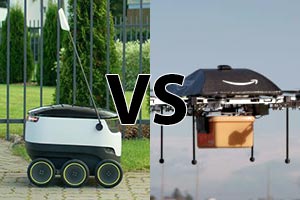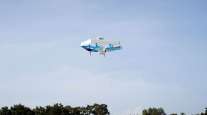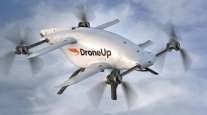Robots May Beat Drones in Race to Deliver Packages

 Photos by Starship Technologies, Amazon.com
Photos by Starship Technologies, Amazon.comForget flying drones. When it comes to predictions on what sci-fi method might bring you hot pizza, aspirin, groceries or new shoes, some experts bet that delivery robots rolling down sidewalks will beat out airborne couriers.
Getting your purchases to your front door — the “last mile” challenge — is an obsession throughout the multibillion-dollar logistics and e-commerce industries. While Amazon, Google and Wal-Mart pursue flying delivery drones, some much smaller companies are quietly working on simpler autonomous solutions anchored on terra firma. They’ve crafted suitcase-size, battery-powered, driverless machines on wheels that can glide along on sidewalks using sensors to avoid collisions.
Startup Dispatch on April 6 scored a $2 million investment round led by Andreessen Horowitz to develop a delivery robot named Carry. Estonia’s Starship Technologies, started by two of the folks behind Skype, is far along on its own eponymous bot — and doing a lot of testing in Wal-Mart’s home state of Arkansas, stirring speculation that the retail juggernaut is interested. Domino’s Pizza recently unveiled DRU, or Domino Robotic Unit, a pizza-delivery robot developed by the Australian military. A handful of other startups are hard at work.
“These R2D2-like drones . . . make a lot of sense for particularly dense places, like city centers, where freight and delivery vehicles are simply running out of space on the roads during rush hours and lunch times,” said Paul Mackie, a spokesman for the Mobility Lab, which researches advanced transportation options.
Allan Martinson, Starship’s chief operating officer, put it like this: “It doesn’t make sense to drive a 2-ton car to deliver 2 pounds of something. It wastes energy, time and CO2.”
Janus Friis, one of Skype’s two main co-founders, and Ahti Heinla, one of four Skype founding engineers and its chief technical architect, launched Starship two years ago after entering a NASA contest to build robots to collect samples on other planets. They quickly repurposed their NASA entry for terrestrial use and now are testing about 10 of the autonomous vehicles, which look like miniature VW vans. Starship is now building them at a pace of one a month, a figure that Martinson said can soon ramp up. By fall, the robots will have logged about 30,000 miles in tests in European and American cities, he said.
Unlike industrial robots on factory floors, warehouses or hospitals, Starship and Carry must have some “social” skills, as they’ll interact with pedestrians as they trundle along sidewalks and cross city streets.
Nine-month-old Dispatch has produced two of its robots, each about 3 cubic feet in size. It’s testing them on the campuses of Menlo College in Silicon Valley and California State University at Monterey Bay.
“The great thing about college campuses is that they are dynamic with bikes, skateboards, pedestrians,” said Dispatch CEO and co-founder Stav Braun. “It’s a great environment to train our system.”
Legality could be a stumbling block for the robots. “There aren’t pre-existing regulatory frameworks,” said Uriah Baalke, Dispatch CTO and co-founder.
But the ground-based delivery bots, which generally will stick to sidewalks, going along at a walking pace of about 2 to 4.5 mph, should be easier to accommodate legally than unmanned aircraft systems or self-driving cars.
Segway scooters, though operated by humans, faced similar concerns. In 2002, the Board of Supervisors banned the devices from sidewalks, though the two-wheeled vehicles eventually became familiar sights on streets in the city’s tourist districts.
City lawmakers in Washington, D.C., soon will consider a precedent-setting bill, the Personal Delivery Device Act of 2016, that would legalize driverless couriers in the nation’s capital. Meanwhile, the United States is still thrashing out laws for airborne commercial drones. Just last week, the Federal Aviation Administration received new recommendations that could clear the way for drones to deliver packages and perform other tasks.
In the drones vs. robots smackdown, both Starship and Dispatch can tick off plenty of pluses for their side.
“Drones are great for lightweight packages and if you need to travel somewhere quickly, especially where there’s not a lot of infrastructure,” Baalke said. “Our vehicle can carry larger payloads and can travel in a more convenient way. It’s more efficient on the ground.”
Martinson noted that the safety concerns between the two are dramatically different. “If a drone falls out of the sky, it could cause considerable damage, even death. There can always be a situation where it encounters a bird or a balloon.”
By contrast, the land rovers simply stop if something goes wrong. “Our machine is basically a suitcase driving at 4 mph,” he said. “You’d need to get really creative to get hurt by it.”
Starship and Carry can accommodate about the same amount of stuff (the size of three or four grocery bags), but they have some differences under the hood in how they sense the world around them.
Both run on electric batteries that can be recharged or swapped out easily. Both will interact with customers via a smartphone app. People will be able to see the robots approaching on a map on their phone, get pinged when they arrive and receive a code to unlock the compartment holding their purchase.
Deliveries could go both ways, particularly useful because about 30% of online fashion orders get returned, Martinson said. “You can imagine ordering five pairs of shoes, trying them on and immediately sending back four pairs,” he said.
Although the bots are designed for autonomous operation, a Starship can be remotely controlled by distant operators. One human can oversee about 100 robots, Martinson said.
Starship said it will soon announce its first paying customers. Dispatch said it’s in talks with retailers and on-demand delivery services. It hopes to offer Carry’s services rather than selling robots outright..
“As cities reimagine themselves to become more walkable, livable places, sidewalks have a central role to play,” said Mackie, the transport futurist. “More and more, people are demanding outdoor living rooms like plazas, sidewalk benches, fountains, cafes and street trees. Frankly, these robots fit into such a landscape much better and much more attractively than the delivery vans and trucks of old.”




